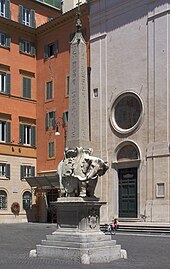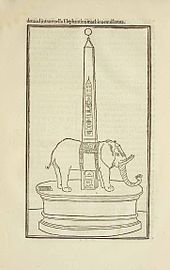Bernini's elephant

Bernini's elephant is an obelisk-bearing in front of the Basilica of Santa Maria sopra Minerva in Rome, created by Ercole Ferrata based on a design by Gian Lorenzo Bernini . The complete work Obelisco della Minerva was installed in 1677 in the Piazza della Minerva .
Emergence
After an Egyptian obelisk was found buried in the garden of the Dominican Church in 1665, Pope Alexander VII commissioned the sculptor and architect Gian Lorenzo Bernini to build a base for this obelisk.
Bernini's idea of using an elephant as an obelisk carrier was inspired by a woodcut in Hypnerotomachia Poliphili , a Renaissance novel published in Italy in 1499.
It is assumed that Bernini made studies of an elephant as early as 1630, which at the time - as the first elephant in Rome after a good hundred years - caused a similar sensation as Hanno , the elephant of Pope Leo X in 1514 , and these templates in turn were used for the design of the Sculpture were used.
The first fairground elephant
In 1626 an elephant of unknown origin is documented in Paris. It is said to have belonged to a private man Mijnheer Sevender , who allegedly taught the animal how to smoke a pipe, which was not good for his health, and who first gave it to King Louis XIII. and then showed around in other places. In a letter dated January 4, 1627, the scholar and archaeologist Nicolas de Peiresc expressed his relief that the elephant had not died and would like a knowledgeable anatomist for a given death. In 1627 the scholar David Ferrand, who had seen the elephant in Rouen, published a pamphlet entitled Discours apologetique en faveur de l'insinct et nature admirable de l'Elephant . Since nothing more was known about the further path of this elephant, it is assumed that the animal is identical to an elephant that caused a sensation in Frankfurt, Nuremberg and later in Austria and Italy from 1629.
This elephant was put on display in April 1629 in Frankfurt am Main for the fasting mass. He came from Amsterdam, nothing more is known about his origin. On May 2, the same year he came to Nuremberg , where not only vil thousand of them gathered to him at the Heuwag for the entrance fee of 2 chunk to admire, but also the scholars took it as an opportunity for discourse. After seeing the miracle animal , Caspar Horn wrote a historical and philosophical treatise entitled Elephas , which appeared in Nuremberg that same year.
On July 7th the elephant was shown in Memmingen , the visitor paid 1 Batzen. In October 1629 he performed in Graz, where the host of the inn renamed his Gasthof Zum Elefanten on this occasion , as had happened 80 years earlier in the Alps when Solimans , Maximilian's elephant , traveled from Spain to Vienna.
In May 1630 the elephant reached Rome and in the course of 1631 by ship France, where he stayed in Toulon and Aix . A received showman's ticket can be interpreted as an indication that the elephant may have traveled on from France to England.
reception
A copy of this extraordinary monument is in Catania (Sicily) in the Piazza del Duomo. In 1736 Giovanni Battista Vaccarini created the Fontana dell'Elefante based on the famous Roman model ; here an elephant made of lava rock carries a small Egyptian obelisk.
The work inspired Carl Jacobsen to design the elephant gate , part of the Carlsberg headquarters in Copenhagen .
In the essay volume Rome - An Ecstasy by Hanns-Josef Ortheil , a stroll through Rome leads past the curious monument.
literature
- William S. Heckscher: Bernini's Elephant and Obelisk. In: The Art Bulletin. 29, 1947, pp. 155-182.
- Stephan Oettermann : The elephant curiosity. An Elephantographia Curiosa . Syndikat, Frankfurt am Main 1982, ISBN 3-8108-0203-4 , pp. 120-124.
- Hanns-Josef Ortheil : Rome - an ecstasy . Sanssouci in Carl Hanser Verlag, Munich 2009, ISBN 978-3-8363-0165-7
Web links
Individual evidence
- ^ William S. Heckscher: Bernini's Elephant and Obelisk. 1947, p. 155.
- ^ William S. Heckscher: Bernini's Elephant and Obelisk. 1947, p. 155 ff.
- ↑ According to Oettermann (1982) pp. 119-120; also in Heckscher (1947) p. 158, p. 177; Note 117
- ↑ Caspar Horn: Elephas. This is historical and philosophical discourse / of the great miracle animal, the elephant / whose wonderful nature and eyesight; like that for the longest time in Germany / and seen by many thousands of people. Outside of reinforced old and new histories, compiled and written by Caspar Hornium Phil & Med Doctorem . Simon Waldmayer, Nuremberg 1629. ( digitized version )
- ↑ Stephan Oettermann : The curiosity of the elephant. An Elephantographia Curiosa. 1982, p. 124.
- ↑ Visit Carlsberg ( Memento of July 2, 2014 in the Internet Archive ), accessed on November 24, 2011.
Coordinates: 41 ° 53 ′ 52.7 " N , 12 ° 28 ′ 39.2" E


